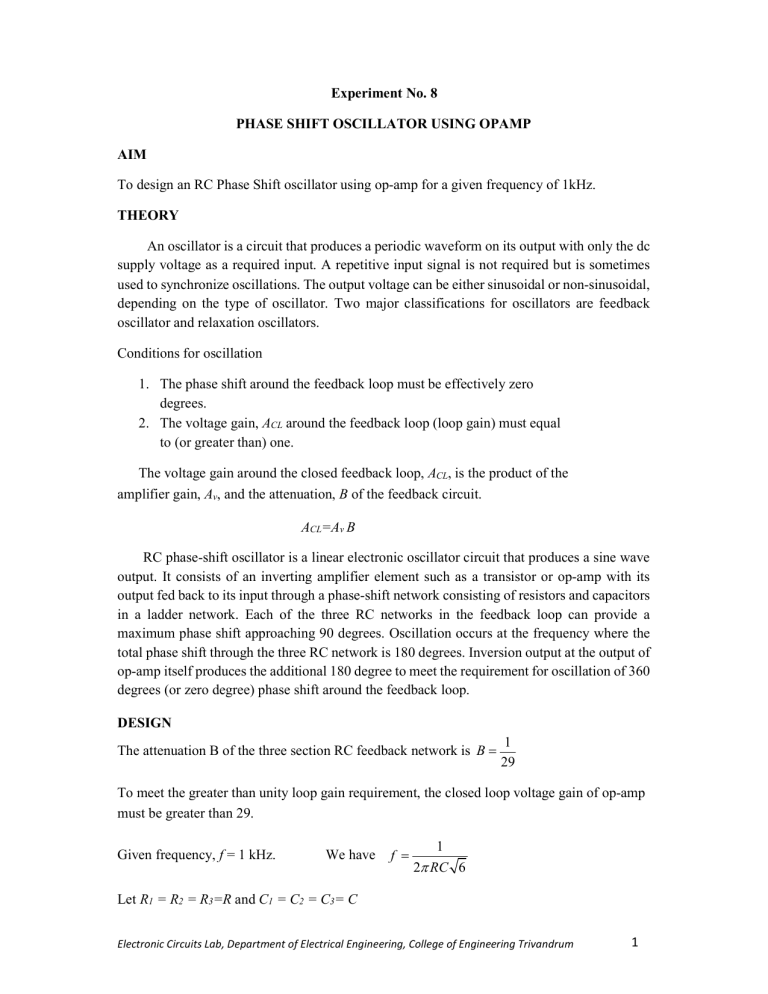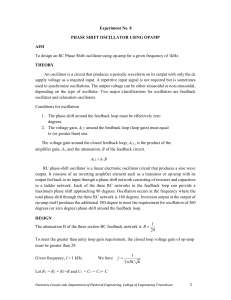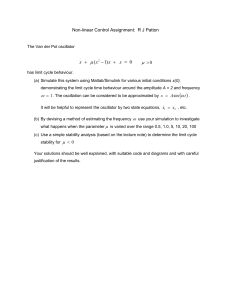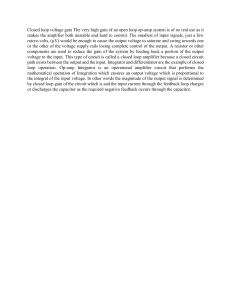
Experiment No. 8 PHASE SHIFT OSCILLATOR USING OPAMP AIM To design an RC Phase Shift oscillator using op-amp for a given frequency of 1kHz. THEORY An oscillator is a circuit that produces a periodic waveform on its output with only the dc supply voltage as a required input. A repetitive input signal is not required but is sometimes used to synchronize oscillations. The output voltage can be either sinusoidal or non-sinusoidal, depending on the type of oscillator. Two major classifications for oscillators are feedback oscillator and relaxation oscillators. Conditions for oscillation 1. The phase shift around the feedback loop must be effectively zero degrees. 2. The voltage gain, ACL around the feedback loop (loop gain) must equal to (or greater than) one. The voltage gain around the closed feedback loop, ACL, is the product of the amplifier gain, Av, and the attenuation, B of the feedback circuit. ACL=Av B RC phase-shift oscillator is a linear electronic oscillator circuit that produces a sine wave output. It consists of an inverting amplifier element such as a transistor or op-amp with its output fed back to its input through a phase-shift network consisting of resistors and capacitors in a ladder network. Each of the three RC networks in the feedback loop can provide a maximum phase shift approaching 90 degrees. Oscillation occurs at the frequency where the total phase shift through the three RC network is 180 degrees. Inversion output at the output of op-amp itself produces the additional 180 degree to meet the requirement for oscillation of 360 degrees (or zero degree) phase shift around the feedback loop. DESIGN The attenuation B of the three section RC feedback network is B 1 29 To meet the greater than unity loop gain requirement, the closed loop voltage gain of op-amp must be greater than 29. Given frequency, f = 1 kHz. We have f 1 2 RC 6 Let R1 = R2 = R3=R and C1 = C2 = C3= C Electronic Circuits Lab, Department of Electrical Engineering, College of Engineering Trivandrum 1 Assume C = 0.01μF. R 1 2 f C 6 Rf 220 kΩ R1 6.8 kΩ +12V 1 2 10 0.01106 6 6.5 k 2 3 7 - LM 741 3 Select nearest value of 6.8 kΩ for R + 6 Vo 4 -12V R f ACL R1 29 6.8 103 197.2 k Select nearest value of 220 kΩ for Rf C1 0.01μF C2 0.01μF R2 6.8 kΩ R3 6.8 kΩ C3 0.01μF PROCEDURE: On a bread board, set up the circuit as shown in the figure. Obtain the sine wave at the output. Check for the frequency obtained. EXPECTED OUTPUT RESULT An RC phase shift oscillator was designed for a frequency of 1kHz. The observed frequency is _______________ kHz Electronic Circuits Lab, Department of Electrical Engineering, College of Engineering Trivandrum 2






